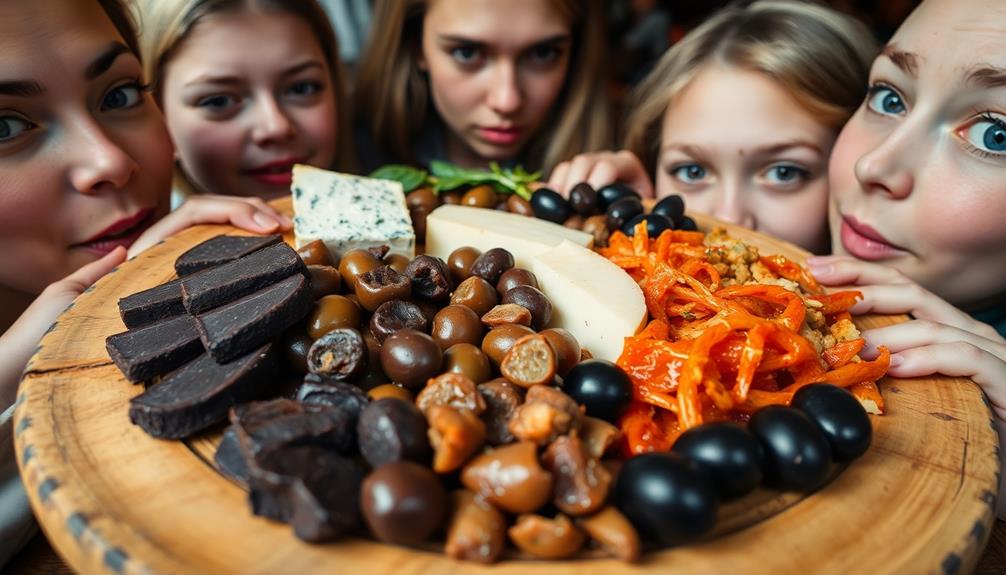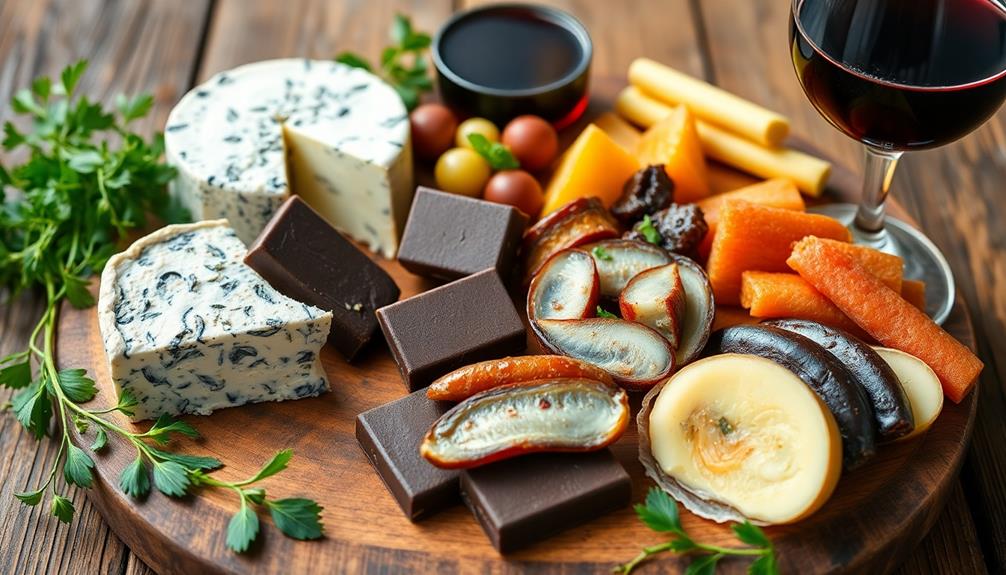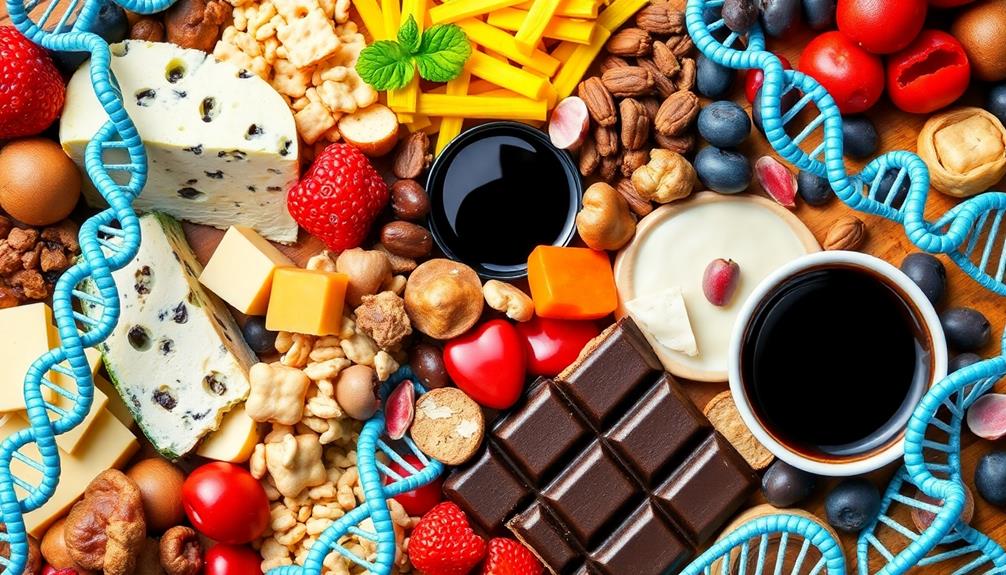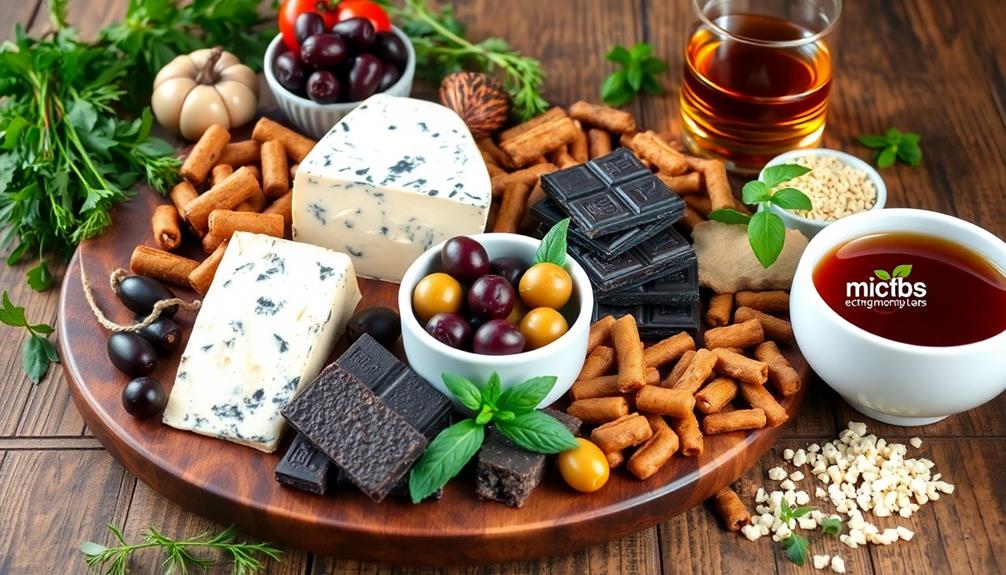Some foods, like coffee and blue cheese, are seen as acquired tastes because you often need to encounter their complex flavors multiple times before you appreciate them. Your experiences, along with cultural influences, play a huge role in how your taste develops over time. Repeated exposure can change your initial aversion into enjoyment, while positive memories associated with these foods can enhance their appeal. Genetic factors also influence your sensitivity to certain flavors. With the right approach, you can learn to embrace new tastes and expand your palate. There's much more to explore about how these dynamics shape your food preferences.
Key Takeaways
- Acquired tastes develop through repeated exposure, allowing individuals to gradually appreciate complex flavors in foods like coffee and blue cheese.
- Cultural backgrounds influence taste preferences, as family meals and cultural festivals introduce diverse flavors, promoting acceptance over time.
- Genetic predispositions, such as sensitivity to bitter flavors, impact individual enjoyment of certain foods, contributing to the acquired taste phenomenon.
- Positive emotional experiences linked to specific dishes can transform initial aversions into favorites, enhancing the overall appreciation of those flavors.
- Gradual exposure and mindful eating strategies encourage the acceptance of previously unappealing foods, fostering a more adventurous palate.
Understanding Acquired Tastes

When you think about your favorite foods, it's easy to forget that some of them weren't always on your plate. Acquired tastes, like coffee or blue cheese, often start off as bitter or unappealing. Over time, you learn to appreciate these flavors through repeated exposure and positive experiences.
For instance, dishes like Red-Braised Pork Belly can initially seem rich and overwhelming, but with familiarity, their complex flavors can become comforting. Your taste preferences can shift as you become familiar with the unique textures and profiles of certain foods, sometimes influenced by cultural and social contexts.
Genetics also plays a role in how you perceive these tastes. Variations in your taste receptor sensitivity can make some flavors more intense or off-putting initially. However, if you gradually introduce yourself to foods you once disliked, you might find your aversions fading away.
Familiarity can work wonders, allowing you to explore foods you never thought you'd enjoy. Psychological factors, like emotional connections and past experiences with specific foods, can further shape your tastes and preferences.
As you open your palate to new experiences, you might discover that what once seemed bitter and uninviting can become a beloved part of your culinary repertoire.
Factors Influencing Taste Acquisition

Your journey into developing a taste for certain foods is influenced by various factors beyond just personal preference. One significant factor is your genetic predispositions. For instance, if you carry the TAS2R38 gene, you might be more sensitive to bitter flavors, which could shape your feelings about foods like black coffee or Brussels sprouts. These genetic tendencies interact with your environment and experiences, further shaping your palate. Cultural influences, exposure to different cuisines, and even memories associated with certain meals can all play a role in what you enjoy. Interestingly, the phenomenon of why food tastes better made by others might also stem from a reduced association with the effort involved in preparation, allowing you to simply savor the flavors without the mental burden of cooking.
Additionally, the diverse flavors in Brazilian cuisine, such as the rich spices in Caruru, can create a unique tasting experience that may take time to appreciate.
Cultural background also plays an essential role in taste acquisition. What's considered a delicacy in one culture might be viewed as unappealing in another. This social context helps mold your taste perception from an early age.
Additionally, if you were exposed to a variety of flavors as a child, you're likely to be more accepting of those foods as an adult.
Repeated exposure to certain foods can further shift your preferences. Initially unappealing flavors might become enjoyable over time due to the process of taste habituation.
However, psychological factors, like past negative experiences with specific foods, can create lasting aversions that affect your willingness to try similar flavors in the future. Understanding these influences can help you navigate your culinary journey more openly.
Common Examples of Acquired Tastes

Although many foods may seem unappealing at first, they often become acquired tastes that people grow to enjoy over time.
Take coffee, for instance. You might find its bitter flavors off-putting initially, but with repeated exposure, it can transform into a daily ritual—after all, over 2.25 billion cups are consumed globally each day!
Similarly, blue cheese's pungent and tangy profile might leave you hesitant at first, but many find it delightful after trying it a few times.
Kimchi is another example; its strong aroma and fermented nature mightn't win you over immediately, yet it's a beloved staple in many cultures, often served as a crucial essential side dish in Korean meals.
Then there are raw oysters. While their slippery texture and briny flavor can make them a challenge for newcomers, many aficionados swear by their unique taste.
Finally, haggis, with its unconventional ingredients, often requires both cultural context and time before it's accepted, but once you embrace it, you might find it surprisingly enjoyable.
These foods demonstrate how your palate can evolve, revealing a world of flavors you never thought you'd appreciate.
Cultural Impact on Food Preferences

Food preferences are deeply intertwined with cultural backgrounds, shaping what you find appealing or unappetizing. For instance, while raw fish is a delicacy in Japan, it might seem unappealing to someone from a different culture.
Your exposure to traditional dishes and communal meals can greatly influence your willingness to try foods that initially seem foreign, such as Kue Putu or Dadar Gulung, which may be unfamiliar but offer unique flavors and textures.
Here are a few ways culture impacts your food preferences:
- Family Meals: Sharing traditional dishes at the family table can foster an appreciation for flavors you mightn't enjoy at first.
- Cultural Festivals: Attending celebrations allows you to encounter unique foods, like haggis or durian, and discover new tastes.
- Globalization: Increased access to diverse cuisines means you can experience flavors from around the world, leading to an acquired taste for items like kimchi or spicy curries.
- Social Media Influence: Trends on platforms can shape your perception of what's desirable, making foods like craft beers or stinky tofu more accepted.
Genetic Influences on Taste

Your taste preferences are shaped not just by what you've tried but also by your genetics.
For instance, if you're a supertaster, you might find bitter foods like Brussels sprouts overwhelming, while others enjoy them.
This genetic variation can even extend to preferences for certain cuisines, such as enjoying the bold flavors of Chicken Chettinad or the sweetness of desserts like Rasgulla.
Understanding these genetic influences can help explain why your friends might savor flavors you can't stand.
Genetic Taste Sensitivity
When it comes to taste sensitivity, genetics play a pivotal role in shaping your preferences and aversions. Your genetic predispositions can greatly influence how you experience flavors, particularly bitter tastes. The TAS2R38 gene is essential in this process, determining whether you're a 'supertaster' with heightened sensitivity to bitterness or a 'non-taster' who finds those flavors less intense.
This can affect your enjoyment of certain foods, including traditional Japanese dishes that may feature unique flavors, like Umeboshi and its tartness, which can be polarizing depending on your taste sensitivity.
Understanding your genetic taste sensitivity can help you navigate your food choices. Here are some ways it affects your taste experience:
- Bitter Foods: You might love or loathe foods like black coffee or dark chocolate based on your genetic makeup.
- Acquired Tastes: Some flavors, like olives or anchovies, may take time to enjoy, particularly for those sensitive to bitterness.
- Food Preferences: Your sensitivity can steer you toward or away from specific cuisines and ingredients.
- Nutritional Choices: Your taste receptors, influenced by genetics, can even impact your dietary habits and health.
Embracing your unique genetic taste sensitivity can lead to a more enjoyable culinary journey.
Cultural Flavor Exposure
Cultural flavor exposure greatly shapes how you perceive and enjoy different tastes, intertwining with your genetic predispositions. Your cultural background plays a pivotal role in defining what you consider acquired tastes.
For instance, if you grew up enjoying bitter flavors like coffee or dark chocolate, you're more likely to embrace these foods as you age. Conversely, if they were absent from your early experiences, you might find them less appealing.
Similarly, traditional dishes like Muamba De Galinha from Angola, with their rich flavors and unique ingredients, can influence your palate based on your cultural context.
Genetic factors, such as the TAS2R38 gene, influence your sensitivity to bitter compounds, affecting how your taste buds react to certain foods. If you're a supertaster, you might experience a stronger aversion to these flavors, while non-tasters may find them more palatable.
This variability in taste perception can lead to differing acceptance levels of foods traditionally categorized as acquired tastes.
Ultimately, your taste preferences are a blend of genetic influences and the flavors you're exposed to from a young age. Early flavor exposure conditions your palate and shapes your willingness to try new foods, making cultural flavor exposure a key element in your culinary journey.
Embracing diverse tastes can broaden your experiences and enhance your enjoyment of food.
Psychological Aspects of Taste

Your taste preferences often evolve based on your experiences and the people around you. When you try new foods, familiarity can turn initial aversions into favorites, especially with encouragement from friends or family.
For instance, dishes like Nettle and Potato Soup may initially seem unusual, but their nutritional benefits can change perceptions over time.
Plus, the memories tied to certain flavors can make them more appealing, showing how powerful the psychological aspects of taste really are.
Familiarity and Acceptance
Familiarity plays an essential role in shaping your taste preferences and acceptance of various foods. When you encounter specific flavors repeatedly, you often find that your initial aversions lessen over time. This phenomenon, known as taste habituation, enables you to appreciate foods that once seemed unappealing.
For example, dishes like Chilaquiles and Quesadillas showcase how familiar flavors can lead to a greater acceptance of diverse ingredients.
Here are some key points to reflect upon:
- Repeated Exposure: The more you try a food, the more likely you're to accept it.
- Emotional Connections: Positive memories associated with certain dishes can enhance your willingness to try them again.
- Social Settings: Enjoying food in group settings encourages you to explore flavors, especially when others express delight.
- Nostalgia: Foods tied to cultural significance or cherished moments can evoke fond feelings, making you more open to trying them.
Social Influences on Taste
Exploring new foods often hinges on the social contexts in which you find yourself. In social settings, like shared meals or cultural festivals, you're encouraged to try new dishes that might initially seem unappealing. This willingness to experiment is often amplified by peer pressure, where you feel the urge to conform to group norms and taste what others enjoy.
For instance, trying local delicacies such as Khanom Tan or Sai Oua can enhance the communal experience and deepen connections with others. Your emotional experiences tied to these interactions can also play a notable role. Positive memories linked to specific foods can enhance your appreciation, making you more open to flavors you once disliked.
Furthermore, marketing and social media representations can shape your perceptions of what's trendy, nudging you toward trying foods that gain popularity through collective enthusiasm. Exposure to diverse cuisines through travel or various social circles can broaden your palate, making once-avoided foods more acceptable as you become more familiar with them.
Each dish you try could lead to new emotional connections, transforming your understanding of what constitutes a pleasurable taste. Ultimately, the social influences surrounding you can considerably impact your food preferences and the development of acquired tastes.
Strategies for Developing Taste

Developing a refined palate often requires intentional strategies that make the journey enjoyable rather than intimidating. Here are some effective methods to help you embrace acquired tastes:
- Gradual Exposure: Start by trying small bites of foods you dislike. Over time, this can help you acclimatize to their flavors and textures.
- Mindful Eating: Focus on the flavors, aromas, and textures of your food. By being present during meals, you can deepen your appreciation for different tastes.
- Experiment with Cooking Methods: Different cooking techniques can change how a food tastes. For instance, roasting Brussels sprouts can enhance their natural sweetness, making them more enjoyable.
- Seek Encouragement: Share your tasting experiences with friends or family. Supportive company can create a positive atmosphere, making it easier to explore new flavors.
Health Implications of Acquired Tastes

Acquired tastes can greatly enhance your health by encouraging you to incorporate more nutrient-dense foods into your diet. Foods that may initially seem unappealing, like bitter vegetables and fermented items, can lead to healthier eating habits. Learning to enjoy flavors like those in dark chocolate or kale helps boost your nutrient intake, promoting better overall health through beneficial compounds.
Research shows that exposure to diverse flavors broadens your dietary variety, essential for obtaining a wide range of nutrients necessary for peak health. When you begin to appreciate fermented foods like kimchi and yogurt, you're not just expanding your palate; you're also potentially improving your gut health. These foods contain probiotics that foster a healthier digestive system.
Moreover, acquiring tastes for nutrient-rich foods such as anchovies for omega-3 fatty acids or blue cheese for calcium can positively influence your long-term dietary habits and overall nutritional profile.
Frequently Asked Questions
What Is the Rule of Acquired Taste?
The rule of acquired taste suggests that you'll often find certain foods unappealing at first, but through repeated exposure and positive experiences, you can learn to enjoy their unique flavors and textures over time.
What Is Acquired Sense of Taste?
When it comes to taste, you often find yourself tasting the waters before diving in. An acquired sense of taste develops through repeated exposure, allowing you to appreciate flavors that once seemed unappealing.
Why Is Beer an Acquired Taste?
Beer's an acquired taste because its complex flavors, like bitterness from hops, often require repeated exposure. As you explore different styles and share experiences with friends, your palate gradually adjusts and appreciates these unique profiles.
Is Taste an Acquired Trait?
Imagine cavemen savoring berries; taste isn't purely inherited. It's shaped by experiences, exposure, and culture. So, yes, your taste can evolve over time, adapting to new flavors and preferences as you grow and explore.
Conclusion
So, next time you take a sip of that bitter coffee or savor a funky blue cheese, remember—your taste buds might just be playing hard to get. Isn't it funny how the foods we once turned our noses up at can become our favorites? Embracing these acquired tastes not only expands your palate but also connects you to cultures and experiences. Who knew that developing a taste for something could feel like a rite of passage? Cheers to your culinary adventures!










